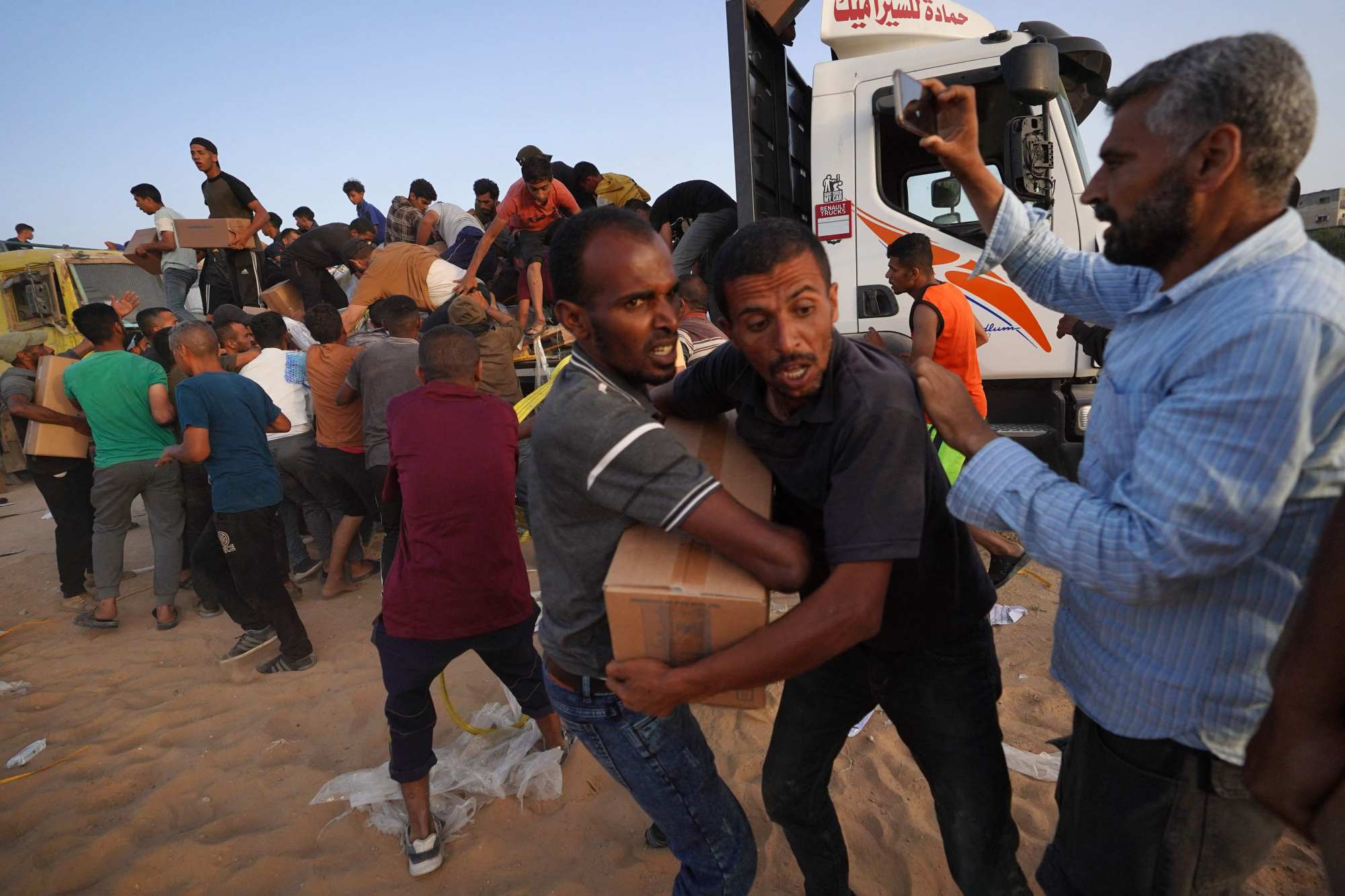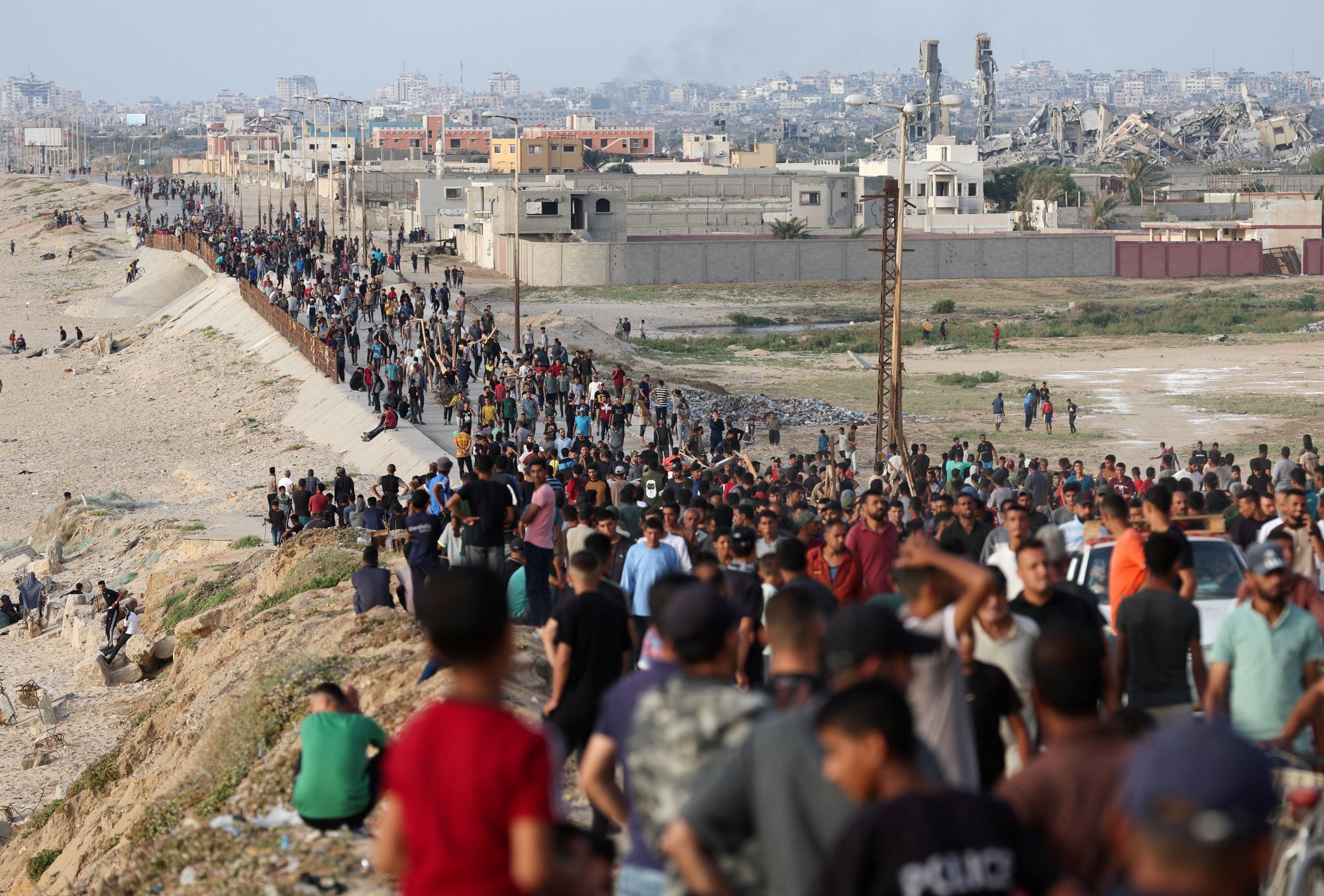
Israel-Gaza war: new US sea route for aid may fail unless conditions improve, UN warns
- The UN has planned new routes within Gaza to transport aid from a US-built floating pier
- Crowds of desperate Palestinians intercepted and looted trucks, causing a halt to deliveries
The UN World Food Programme said the new US$320 million pier project for delivering aid to Gaza may fail unless Israel starts ensuring the conditions the humanitarian groups need to operate safely.
The operation was halted for at least two days after crowds looted aid trucks coming from the port and one Palestinian man was killed.
Deliveries were stopped Sunday and Monday after the majority of the trucks in an aid convoy Saturday were stripped of all their goods on the way to a warehouse in central Gaza, the WFP said on Tuesday.
The first aid transported by sea had entered the besieged enclave on Friday.

The Pentagon said movement of aid from the secured area at the port resumed Tuesday, but the UN said it was not aware of any deliveries.
The UN food agency is now re-evaluating logistics and security measures and looking for alternate routes within Gaza, said spokesperson Abeer Etefa. The WFP is working with the US Agency for International Development to coordinate the deliveries.
Only five of the 16 aid trucks that left the secured area on Saturday arrived at the intended warehouse with their cargo intact, another WFP spokesperson, Steve Taravella, told Associated Press. He said the other 11 trucks were waylaid by what became a crowd of people and arrived without their cargo.
“Without sufficient supplies entering Gaza, these issues will continue to surface. Community acceptance and trust that this is not a one-off event are essential for this operation’s success,” Taravella said in an email. “We have raised this issue with the relevant parties and reiterated our request for alternative roads to facilitate aid delivery. Unless we receive the necessary clearance and coordination to use additional routes, this operation may not be successful.”
The WFP also said Tuesday it has suspended food distribution in the southern Gaza city of Rafah due to a lack of supplies and insecurity.
US President Joe Biden ordered the US military’s construction of the floating pier for deliveries of food and other vital supplies.

Israeli restrictions on shipments through land borders and overall fighting have put all 2.3 million residents of Gaza in a severe food crisis since the war between Israel and Hamas began in October, and US and UN officials say famine has taken hold in the north of Gaza.
Authorities have offered limited details of what transpired with Saturday’s aid convoy. However, Associated Press video shows Israeli armoured vehicles on a beach road, then aid trucks moving down the road.
Civilians watching from the roadside gradually start to clamber on top of the aid trucks, throwing aid down to people below. Numbers of people then appear to overrun the aid trucks and their goods.
At one point, people are shown carting a motionless man with a chest wound through the crowd. A local morgue later confirmed the man had been killed by a rifle shot. At another point, shots crackled, and some of the men in the crowd are shown apparently ducking behind aid boxes for cover.
It was not clear who fired the shots. The Israeli military is responsible for security for the aid when it reaches the shore. Once it leaves the secure area at the port, aid groups follow their own security protocols.
Asked about the shooting, the Israeli army told AP, using the acronym for the Israel Defence Forces: “The IDF is currently focused on eliminating the threat from the terrorist organisation Hamas”.
UN spokesman Stephane Dujarric told reporters Tuesday that the aid convoys do not travel with armed security.
He said the best security comes from engagement with various community groups and humanitarian partners so people understand that there will be a constant flow of aid. “That is not possible in an active combat zone,” Dujarric said.
The Pentagon press secretary, Major General Pat Ryder, said that as of Tuesday 569 tonnes of aid has been delivered to the secured area at the Gaza port. Some of it remains there, however, because distribution agencies are working to find alternative routes to warehouses in Gaza.
Asked if any aid from the pier had yet reached Gaza residents in need, Ryder said: “I do not believe so”. He said aid had resumed moving Tuesday from the secured area into Gaza, after what had been a two-day halt following Saturday’s disruption. He gave no immediate details.
Etefa, the WFP spokesperson in Cairo, said she knew of no deliveries from the shore on Tuesday, however.
Biden announced the US mission to open a new sea route for humanitarian goods during his State of the Union address in March, as pressure built on the administration over civilian deaths in Gaza.

The war began in October after a Hamas-led attack killed about 1,200 people in Israel. Israeli air strikes and fighting have killed more than 35,000 Palestinians since then, Gaza health officials say.
Many international humanitarian organisations were critical of the US project, saying that while any aid was welcome, surging food through the land crossings was the only way to curb the growing starvation.
Jeremy Konyndyk, a former USAID official now leading the Refugees International humanitarian organisation, called the pier operation “humanitarian theatre” and said it was being done for political effect.
The UN says some 1.1 million people in Gaza – nearly half the population – face catastrophic levels of hunger and that the territory is on the brink of famine.
The crisis in humanitarian supplies has spiralled in the two weeks since Israel began an incursion into Rafah on May 6, vowing to root out Hamas fighters. Troops seized the Rafah crossing into Egypt, which has been closed since.
Since May 10, only about three dozen trucks have made it into Gaza via the nearby Kerem Shalom crossing from Israel because fighting makes it difficult for aid workers to reach it, the UN says.
Taravella said little aid or fuel – needed to run aid delivery trucks – is currently reaching any part of Gaza, and stocks of both are almost exhausted.
“The bottom line is that humanitarian operations in Gaza are near collapse,” he wrote.

